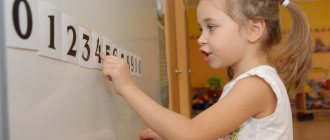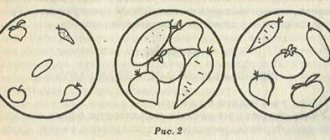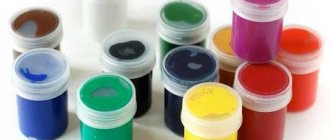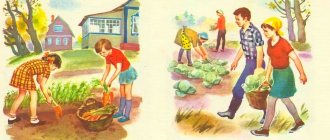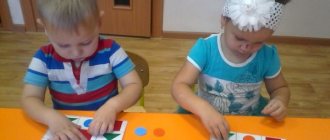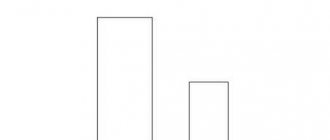Integration of educational areas: cognitive development, speech development, social and communicative development, artistic and aesthetic development, physical development.
Tasks:
"Cognitive development":
introduce a geometric figure - a ball; ordinal number “third”; practice counting up to 3. Activate mental activity through resolving a problem situation. Develop memory, attention, logical thinking. Activate and systematize children’s knowledge and skills.
“Social and communicative development”:
introduce children to the basic rules of interaction with peers in the process of activity, a tolerant attitude towards others, the ability to listen to each other. Create an atmosphere of creative exploration.
"Speech development"
expansion and activation of the dictionary with words: ball, third. Consolidating the use of tree names in speech: birch, oak, spruce, maple.
"Physical development":
improve motor skills.
“Artistic and aesthetic development”:
practice the ability to carefully paint over a silhouette without going beyond the contours of the image.
Methods and techniques:
Practical – games, game exercise;
verbal - conversation, questions, reading a poem;
visual - observations, looking at pictures
Materials and equipment:
demonstration: geometric shapes, a plot picture depicting rectangular objects; a picture depicting objects of different shapes; ball, cube; pictures depicting spruce, birch, oak, ball.
handouts: pictures with silhouette images of trees, colored pencils.
Forms of organizing joint activities
| Children's activities | Forms and methods of organization |
| Visual activities | 1. Task “Paint the tree.” Goal: to consolidate the ability to select the appropriate pencil color to depict parts of a tree. |
| Communication activities | 1. Reading the poem “Ball”. Goal: to be attentive and interested listeners. |
| Cognitive - research | 1. Exercise “Find the ball” Purpose: to consolidate the ability to find objects of the same shape. 2. Game “What to roll?” Goal: teach to think logically by comparing objects. 3. Game exercise “Count the leaves”, “Count the trees”. Goal: to consolidate ordinal counting up to 3, the ability to determine which tree a leaf comes from. |
| Physical activity | 1. Physical education. Goal: activation of motor activity of children. They know how to combine movements with the words of a poem. 2. Sedentary game “Catch and Name” Purpose: to practice catching a ball, to consolidate knowledge of trees. |
Logic of educational activities
| Activities of the teacher | Pupils' activities | Expected results |
| 1. Organizing time. Reviewing what we have learned about geometric shapes Task 1. Includes children in educational activities: Invites them to look at geometric shapes and name them. Task 2. Shows a plot picture and offers to find and name rectangular objects. Task 3. Name any geometric figure. | Show interest in the upcoming topic. Answer questions. They enter into dialogue and offer possible answers. Children name objects that have this shape. | The task is accepted by the children; there is motivation to achieve results in collaboration with the teacher and children. |
| 2. Reading the poem "Ball". I inflate the balloon. I roll it around like a ball, throw it up, and catch it again. I look at his form. It is round, just like a flat circle. But he is a great friend to everyone around. The same shape is an orange, a watermelon, a ball, and a tangerine. I will call the figure that I can roll a ball. | Children listen to a poem. | Interest and desire to listen to the poem are aroused. |
| 3. Exercise "Find the ball." Shows a ball figure. | Children find spherical objects in the picture. | The mental activity of children is activated. |
| 4. Game "What to roll." Draws a line on the floor. Questions: Why does the ball roll faster? Which is more stable: a ball or a cube? | Two children roll a cube and a ball to this line. Children conduct a dialogue with the teacher. Answer questions. | The ability to conduct a coordinated dialogue and be friendly, correct interlocutors has been developed. |
| 5. Counting to 3. Ordinal number “third” . Places 3 pictures of trees (birch, spruce, oak) on the dock. Offers to count the trees and compare their height and thickness. - Name the first tree. (Birch.) - Name the second tree. (Spruce.) - Oak is the third tree. - What kind of tree is birch? - What type of spruce? — What kind of oak? | Children count trees, compare them by height and thickness. Answer questions. | Understand and are able to complete tasks |
| 6. Game exercise “Count the leaves.” He attaches oak, maple, and birch leaves to the board and asks them to name which leaves they are and from which tree. -Which sheet is the first? Second? Third? | They look carefully and name the leaves and answer questions. | Understand and are able to complete tasks |
| 7. Physical education. Offers to play a game, recites a poem: Pine . There is a pine tree in the yard, it reaches towards the sky. Poplar grew up next to her, he wants to be more authentic. A strong wind blew and shook all the trees. The branches bend back and forth, the wind shakes them, bends them. Let's squat together - One, two, three, four, five. We warmed up from the heart and went to the place again. Maple. The wind quietly shakes the maple, tilts to the right, to the left: Once - tilt and twice - tilt, The maple leaves rustled. | Children perform movements and actions behind the teacher. Standing on one leg, stretch - arms up, then do the same while standing on the other leg. Tilts the body back and forth. Hand jerks in front of the chest. Squats. They walk in place. Feet shoulder-width apart, hands behind the head, body tilted to the left, right. | They are able to perform movements and actions for the teacher in accordance with the poetic text. |
| 8. Task “Paint the tree” . Offers each child a picture with a silhouette image of trees. Task: color the second tree yellow, the third green, the first red. | Children sit at tables and complete the task. | They understand and are able to complete tasks. |
| 9. Summary of the lesson. Sedentary game "Catch and name". Throws a ball to each child and asks them to name the tree. Clarifies: which exercise or task was the easiest, most difficult, fun, etc. Makes sure that the children’s answers are complete sentences. | Children catch the ball and say the names of the trees. Children share their impressions of past activities | They know and name the names of trees and can talk about past activities. |
Formation of quantitative concepts and counting activities in children in the middle group
author: Litvinova Elena Yulyusevna
teacher of MADOU "DS No. 213 of Chelyabinsk"
Formation of quantitative concepts and counting activities in children in the middle group
Formation of quantitative concepts and counting activities in children in the middle group
Litvinova E.Yu.
Educator of MADOU "DS No. 213 of Chelyabinsk"
In kindergarten, preschoolers are introduced to counting. Mathematical problems and counting exercises teach children to think, think logically, and expand their understanding of the world around them. The basic concept of elementary mathematics in kindergarten and the basic quantitative concepts of a preschooler is the concept of number. Natural numbers are numbers that arose in the process of counting individual objects (1, 2, 3, etc.) or measuring. Work on developing this concept in children is carried out over three years (in the middle, senior and preparatory groups).
Ideas about quantity and counting in preschoolers begin with the formation of pre-numerical quantitative relationships: equality - inequality of objects in size, equality - inequality of groups in terms of the number of objects included in them. The child begins to understand the mathematical relationships “more”, “less”, “equally”. Only after this does he begin to learn how to count, and is given an idea of numbers within ten, of the relationships between successive numbers, of the quantitative composition of a number of individual units and two smaller numbers.
V.V. Danilova, T.D. Richterman, Z.A. Mikhailova point out that “objective actions of young children are propaedeutics of counting activity.” Actively acting, children of this age scatter objects or, conversely, collect them. As a rule, the child accompanies all identical actions by repeating the same word: “here..., here..., here...”, or “more..., more..., more...”, or “on..., on..., on...”, or chaotic naming of numbers: “one, one, five, etc.” Such actions with sets can be considered as the beginning of the development of counting activities. Children easily learn simple counting rhymes and individual numeral words and use them in the process of movements and games. The early appearance of numerals in the active vocabulary of children (1.5-2 years old) is not an indicator of the formation of quantitative concepts. These words are borrowed from the speech of adults and are used by children during play. At an early age (2-3 years), children move from chaotic knowledge of numerals, under the influence of training, to mastering the sequence of numbers in a limited segment of the natural series. As a rule, these are numbers 1, 2, 3. V.V. Danilova, T.D. Richterman, Z.A. Mikhailova write that “further ordering of numbers in children of 3-4 years of age occurs as follows: increases segment of memorizing the sequence of numerals, children begin to realize that each of the numeral words always occupies its specific place, although they still cannot explain why three always follows two, and six always follows five.” In this case, speech arises - auditory-motor connections between the so-called numerals, which manifest themselves in the fact that in a learned chain of words (one, two, three, etc.) it is completely impossible for a child to replace the word one with the word one. If such a replacement of words occurs, then the connections formed in the child’s mind are destroyed and he becomes silent, not knowing what should follow the word one (in some cases, to please the elders, a 2.5-3 year old child names the word one as preceding all the learned them number chain).
Thus, at an early age, under the influence of active actions with object collections, children develop a speech-auditory motor image of a natural series of numbers.
E.I. Shcherbakova points out that, following speech-auditory-motor images, 3-4-year-old children successfully form an auditory image of a natural number series. Numeral words are lined up and named in order, but this happens gradually: “at first, only a certain set of numerals is ordered, after which the numerals are named, although with the omission of some of them, which the child has not yet memorized, but always in increasing order. Having mastered the numerals of the first ten, children easily move on to the second ten, and then count like this: “Twenty-ten, twenty-eleven,” etc.
By mastering counting, children acquire the ability to determine the number of objects as a result of understanding the final value of the number, to compare sets and numbers with the definition of relationships between them (visually, in words). Comparing numbers (on a visual basis) reveals and highlights the quantitative meaning of a number. V. V. Danilova, T. D. Richterman, Z. A. Mikhailova o. At the same time, children's perception and thinking are restructured. They develop the ability to see the same quantity regardless of external insignificant signs (awareness of the principle of conservation of quantity). This is facilitated by exercises that convince children that the same quantity can be represented from different objects, differ in the size of the occupied area, and location. According to V.V. Danilova, at the age of 4-5, children learn the sequence and names of numerals, accurately correlate the numeral with each set of objects, regardless of their qualitative features and forms of arrangement, and learn the meaning of the last number named when counting as the final number. However, when comparing numbers, the larger of them is determined by its distance from the beginning of counting or as being in front (behind) of any number, which was typical for children at a lower level of mastering the sequence of numbers. L. V. Mikhailova-Svirskaya believes that in older preschool age children master measurement. From the practical comparison of objects by measurement they move on to their quantitative characteristics by counting conventional measures. The number begins to act as the ratio of the whole (measurable quantity) to the part (measure). Developing in a preschooler the ability to answer the question “how much?” words “many”, “few”, “one”, “two”, “the same”, “equally”, “more than...”, “less than...”, etc. speeds up the process of children understanding the knowledge of the final number when counting.” This activity deepens the concept of number.
Throughout the school year, children in the middle group practice counting within 5, and in the older group – within ten. They count objects, toys, count out smaller ones from a larger number of objects, count objects according to a given number, according to a number, according to a pattern. The sample can be given in the form of a number card with a certain number of toys, objects, geometric shapes, in the form of sounds, movements. When performing these exercises, it is important to teach children to listen carefully to the teacher’s tasks, remember them, and then complete them. The middle group program is aimed at further developing mathematical concepts in children. It involves learning to count to 5 by comparing two sets expressed by adjacent numbers. An important task in this section remains the ability to establish the equality and inequality of groups of objects, when the objects are at different distances from each other, when they are different in size, etc. Solving this problem leads children to understand an abstract number.
Grouping objects according to characteristics develops in children the ability to compare and carry out logical classification operations. In the process of various practical actions with aggregates, children learn and use in speech simple words and expressions that indicate the level of quantitative ideas: many, one, one at a time, none, not at all, few, the same, the same, the same, equally; as much as; more than; less than; each of..., all, all.
Children in the middle group must learn counting techniques:
- Name the numbers in order.
- Correlate each numeral with only one object.
- At the end of the count, sum it up in a circular motion and call it by the name of the items counted (for example, “one, two, three. Three dolls in total”). When summing up the count, always pay attention to the fact that children always name the number first, and then the object.
- Learn to distinguish the counting process from the counting total.
- Count with your right hand from left to right.
- During the counting process, name only numerals.
- Teach children to correctly coordinate numerals with nouns in gender, number, case, and give a detailed answer.
Simultaneously with learning to count, the concept of each new number is formed by adding a unit. Throughout the entire academic year, quantitative counting up to 5 is repeated. When teaching counting, in each lesson, special attention should be paid to such techniques as comparing two numbers, matching, establishing their equality and inequality, overlapping techniques and applications.
Counting by touch, counting by ear and counting various movements within 5 are also given.
One of the important tasks in this group is teaching children the ability to count objects. For a child, counting and counting are not the same thing. These are different counting operations. It is advisable to teach counting in a familiar environment for children, where there are fewer distractions. In this case, it is necessary to show children the method of counting, indicate when to pronounce a numeral, selecting objects.
Without knowing how to estimate size, a child often cannot compare the size of objects of different shapes or differently located in space, taking into account, as a rule, only one of the parameters of size, primarily height, which leads to an incorrect decision - to estimates by visual impression.
In order to develop an orientation towards the size of objects as a significant sign and to bring the child to an awareness of the need for measurement as a way of comparing objects by size, an organization of learning is needed that would provoke the child’s own cognitive activity.
Children continue to be taught to compare (measure) objects in width, length, height, thickness by placing them next to each other, making this work more difficult by the fact that objects for comparison are selected with small differences in width, length, height, thickness. This is done in order to show the need for commensurateness. In this case, you should pay attention to the correctness of the measurement: clear alignment of the ends and sides of the objects being measured, the need to use a single reference point.
Work is underway with children to prepare for mastering measurement. This is a comparison of two objects using a third - a conditional measure. For example, on the table, each child has a piece of paper with Christmas trees pasted on it and a strip of paper, from which they must independently make a measurement and use it to determine which of the trees is taller.
When comparing objects, children should be able to arrange them in ascending or descending order by length, width, thickness, and height.
Initially, such a determination is made as a result of direct application of objects to each other, and then children should be able to determine by eye. For example, the teacher asks to give a strip of paper of the same length or to bring an album thicker than what is on the table, etc.
In the middle group, children's knowledge of geometric shapes expands. In addition to circles, triangles and squares, they should be able to distinguish and name rectangles, ovals, and three-dimensional shapes (sphere, cube, cylinder). Get acquainted with forms by examining them tactile-motor and visually.
The methodology for conducting classes to introduce and consolidate the names of geometric figures is the same as in the second junior group.
Geometric shapes are given to children in pairs. First, they give a pair of volumetric and planar forms (a circle and a ball, a square and a cube), and then they can give a pair of volumetric shapes (a cube and a cylinder). In this case, it is necessary to pay attention to their special features (the cube has many angles, the ball and cylinder do not; the ball and cylinder roll, but the cube is stable). Children should be taught to distinguish angles and sides in geometric shapes (a rectangle and a square have 4 corners and 4 sides). At the same time, there is a difference between the figures. The teacher emphasizes it, noting that a square has all the same sides, and a rectangle has two long sides and the other two short. Next, it is recommended to compare the rectangle with a circle and an oval.
Examination and comparison of figures is carried out in a certain sequence:
a) mutual overlap and application of figures; this technique allows you to more clearly perceive the features of figures, similarities and differences, and highlight their elements;
b) organizing the examination of figures by tactile-motor means and identifying some elements and features of the figure; the effect of examining a figure largely depends on whether the teacher directs the children’s observations with his words, whether he indicates what to look at, what to find out (the direction of the lines, their connection, the proportions of individual parts, the presence of angles, vertices, their number, color, size figures of the same shape, etc.); children must learn to verbally describe this or that figure;
c) organizing various actions with figures (rolling, placing, placing in different positions); By acting with models, children identify their stability or instability, their characteristic properties. For example, children try to place a ball and a cylinder in different ways and discover that the cylinder can stand, can lie, can roll, but the ball rolls. In this way, the characteristic properties of geometric bodies and figures are discovered;
d) organizing exercises for grouping figures in order of increasing and decreasing size (“Select by shape”, “Select by color”, “Arrange in order””);
e) organization of didactic games and game exercises to strengthen children’s skills in distinguishing and naming figures (“What’s missing?”, “What’s changed?”, “Wonderful bag”, “Shop”, “Find a pair”, etc.)
They teach children to distinguish between a circle and an oval, to make and lay out different shapes from sticks. For example, make a square out of 4 sticks, a rectangle out of 6, and a triangle out of 3.
The teacher should give the children an idea that figures can be of different sizes: large and small.
It is necessary to train children in arranging figures in ascending or descending order: a large circle, a smaller one, an even smaller one, etc.
The tasks of orientation in space also become more complicated: children not only must determine the direction “away from themselves,” but also move in this direction. Children receive this knowledge in classes and consolidate it in games, on walks, etc.
Children should be able to determine the position of this or that object in relation to themselves (“There is a table in front of me,” “There is a closet on my right,” etc.). Learn to see what is close and what is far from them; Use the terms “close” and “far” correctly.
Preschool age is the most favorable period for the development of mathematical concepts in children, since they have a desire to learn associated with the desire to learn new things.
The features of children's mathematical concepts in preschool age include: connection with play, reliance on the help of an adult, expansion of children's independence in completing tasks, accumulation of a certain stock of subject knowledge and skills, development of the necessary specific cognitive and mental skills that are basic for successful learning. in the future, mathematical and any other generalized content. Formation of quantitative concepts and counting activities in children in the middle group
Middle group. Junior preschool age. Children 4 - 5 years old
Summary of the lesson on FEMP in the middle group “Tasks from the bear. Counting within 5. Geometric figures" Purpose: To consolidate children's knowledge of the formation of elementary mathematical concepts. To identify the level of knowledge, skills and abilities in FEMP. Program content: Educational objectives: • consolidate quantitative and ordinal counting skills within 5 ; • repeat…
Summary of the lesson in the creativity house for students 5–5.5 years old “Number and figure 5” Age of students 5 – 5.5 years The topic of the lesson “ Number and figure 5 ”
Necessary equipment: Demonstration material: geometric shapes, images: Squirrel, Bunny, Teddy Bear, Top, Little Fox, 5 nuts. Handouts: geometric shapes, sticks, handouts...
